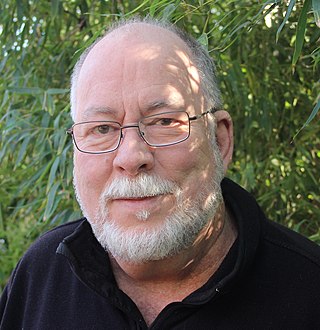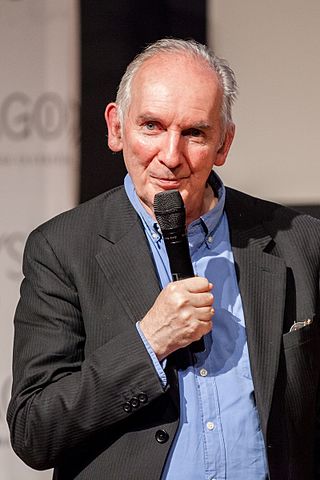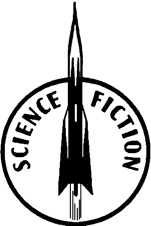
Hannes Bok, pseudonym for Wayne Francis Woodard, was an American artist and illustrator, as well as an amateur astrologer and writer of fantasy fiction and poetry. He painted nearly 150 covers for various science fiction, fantasy, and detective fiction magazines, as well as contributing hundreds of black and white interior illustrations. Bok's work graced the pages of calendars and early fanzines, as well as dust jackets from specialty book publishers like Arkham House, Llewellyn, Shasta Publishers, and Fantasy Press. His paintings achieved a luminous quality through the use of an arduous glazing process, which was learned from his mentor, Maxfield Parrish. Bok shared one of the inaugural 1953 Hugo Awards for science fiction achievement.

Frank Kelly Freas was an American science fiction and fantasy artist with a career spanning more than 50 years. He was known as the "Dean of Science Fiction Artists" and he was the second artist inducted by the Science Fiction Hall of Fame.

Ronald William "Josh" Kirby was a British commercial artist. Over a career spanning 60 years, he was the artist for the covers of many science fiction books including Terry Pratchett's Discworld novels.

Edmund Alexander Emshwiller was an American visual artist notable for his science fiction illustrations and his pioneering experimental films. He usually signed his illustrations as Emsh but sometimes used Ed Emsh, Ed Emsler, Willer and others.

Philip Foglio is an American cartoonist and comic book artist known for his humorous science fiction and fantasy art.

David Cherry is an American artist, author, and illustrator of science fiction and fantasy and has also done substantial work as a marketing artist, concept artist, and 3D modeler in the game production industry. Cherry served as Lecturer and Head of the Art Department as well as Head of the master's degree Program for artists at The Guildhall at SMU, a graduate college dedicated to studies for people who want to work in the game production industry. Cherry was also an attorney, as well as a past president of the Association of Science Fiction and Fantasy Artists (1988–1990). He has been nominated eleven times for Hugo Awards, and 18 times for Chesley Awards.

Alan Lee is an English book illustrator and film conceptual designer. He is best known for his artwork inspired by J. R. R. Tolkien's fantasy novels, and for his work on the concept design of Peter Jackson's film adaptations of Tolkien, The Lord of the Rings and The Hobbit film series.

Michael Whelan is an American artist of imaginative realism. For more than 30 years, he worked as an illustrator, specializing in science fiction and fantasy cover art. Since the mid-1990s, he has pursued a fine art career, selling non-commissioned paintings through galleries in the United States and through his website.
Leo Dillon and Diane Dillon were American illustrators of children's books and adult paperback book and magazine covers. One obituary of Leo called the work of the husband-and-wife team "a seamless amalgam of both their hands". In more than 50 years, they created more than 100 speculative fiction book and magazine covers together as well as much interior artwork. Essentially all of their work in that field was joint.

John Carl Schoenherr was an American illustrator. He won the 1988 Caldecott Medal for U.S. children's book illustration, recognizing Owl Moon by Jane Yolen, which recounts the story of the first time a father takes his youngest child on a traditional outing to spot an owl. He was posthumously inducted by the Science Fiction and Fantasy Hall of Fame in 2015.
Richard Michael Sternbach is an illustrator who is best known for his space illustrations and his work on the Star Trek television series.
Rowena A. Morrill, also credited as Rowena and Rowina Morril, was an American artist known for her science-fiction and fantasy illustration, and is credited as one of the first female artists to impact paperback cover illustration. Her notable artist monographs included The Fantastic Art of Rowena, Imagine, Imagination, and The Art of Rowena and her work has also been included in a variety of anthologies including Tomorrow and Beyond and Infinite Worlds.
Donato Giancola is an American artist specializing in narrative realism with science fiction and fantasy content, including images for Tolkien's Middle-earth. He has won many Chesley Awards and other honors for his illustrations.
Greg and Tim Hildebrandt, known as the Brothers Hildebrandt, are American twin brothers who worked collaboratively as fantasy and science fiction artists for many years. They produced illustrations for comic books, movie posters, children's books, posters, novels, calendars, advertisements, and trading cards. Tim Hildebrandt died on June 11, 2006.
Barclay Shaw is an American professional artist best known for his fantasy and science fiction artwork. He has been nominated five times for the Hugo Award for Best Professional Artist and has earned a top ten ranking six times in the annual Locus Poll Award for Best Artist. In 1995, his work "Wonderland (wood)" won the Chesley Award for Best Three-Dimensional Art.

Winston Science Fiction was a series of 37 American juvenile science fiction books published by the John C. Winston Company of Philadelphia from 1952 to 1960 and by its successor Holt, Rinehart & Winston in 1960 and 1961. It included 35 novels by various writers, including many who became famous in the SF field, such as Poul Anderson, Arthur C. Clarke, Ben Bova, and Lester del Rey. There was also one anthology, The Year After Tomorrow, edited by del Rey and others. There was one non-fiction book Rockets Through Space: The Story of Man's Preparations to Explore the Universe by del Rey which details the factual science and technology of rocket flight. Many of the dust jackets became science fiction classics; the artists included Hugo Award winners Ed Emshwiller and Virgil Finlay along with Hugo nominees such as Mel Hunter and Alex Schomburg.

Nebula Science Fiction was the first Scottish science fiction magazine. It was published from 1952 to 1959, and was edited by Peter Hamilton, a young Scot who was able to take advantage of spare capacity at his parents' printing company, Crownpoint, to launch the magazine. Because Hamilton could only print Nebula when Crownpoint had no other work, the schedule was initially erratic. In 1955 he moved the printing to a Dublin-based firm, and the schedule became a little more regular, with a steady monthly run beginning in 1958 that lasted into the following year. Nebula's circulation was international, with only a quarter of the sales in the United Kingdom; this led to disaster when South Africa and Australia imposed import controls on foreign periodicals at the end of the 1950s. Excise duties imposed in the UK added to Hamilton's financial burdens, and he was rapidly forced to close the magazine. The last issue was dated June 1959.
John Harris is a British artist and illustrator, known for working in the science fiction genre. His paintings have been used on book covers for many authors, including Orson Scott Card, Arthur C. Clarke, Isaac Asimov, Frederik Pohl, Ben Bova, Wilbur Smith, Jack Vance, Ann Leckie, and John Scalzi. His work has covered many genres and although he made his name in the science-fiction genres, he is now exploring a new realm, the imaginative realism of aerial landscapes.
The BSFA Awards are given every year by the British Science Fiction Association. The BSFA Award for Best Artwork is open to any artwork with speculative themes that first appeared in the previous year. Provided the artwork hasn't been published before it doesn't matter where it appears. The ceremonies are named after the year that the eligible works were published, despite the awards being given out in the next year.
Gareth Lyn Powell is a British author of science fiction. His works include the Embers of War trilogy, the Continuance series, the Ack-Ack Macaque trilogy, Light Chaser, and About Writing, a guide for aspiring authors. He has also co-written stories with authors Peter F. Hamilton and Aliette de Bodard.











